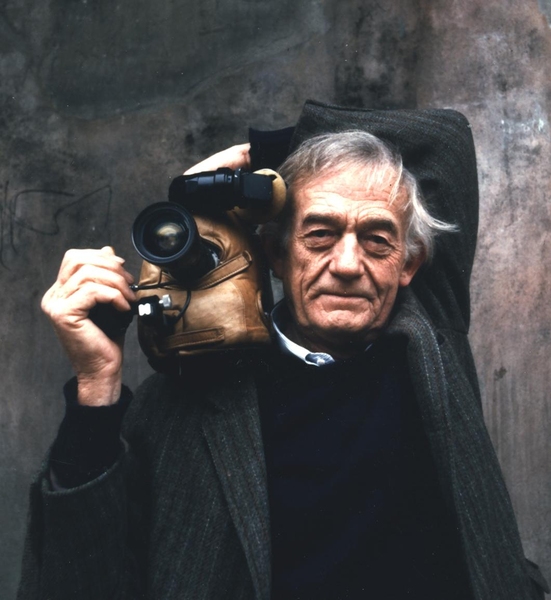Innovative documentary filmmaker Richard Leacock, who helped create the cinéma vérité style and was a driving force behind the film program at MIT, died on March 23 at his home in Paris. He was 89.
Leacock was best known for expanding the possibilities of documentary film through the use of small, mobile, hand-held cameras, which provided documentaries with greater immediacy and opened up the range of subjects and scenes that could be filmed. He also helped devise some of the technical innovations necessary to provide high-quality sound for hand-held cameras.
Leacock's first well-known film was 1954's Toby and the Tall Corn, about a traveling theater troupe in Missouri. He served as the cinematographer for Robert Drew's milestone documentary, Primary, about John F. Kennedy's 1960 presidential campaign, and formed a working partnership with D. A. Pennebaker, for whom he served as cinematographer on Monterey Pop, from 1967, about the celebrated music festival.
In 1968, Leacock joined MIT, at the invitation of then-provost Jerome Wiesner (later the Institute's president), in the Documentary Film Section, a part of the School of Architecture and Planning, and later housed within the Media Lab. Leacock stayed until 1989, when he retired and moved to Paris.
"Ricky's humanity in his films and in his life taught all of us to be better people," said Glorianna Davenport, a visiting scientist at the MIT Media Lab, former head of the Media Lab's Media Fabrics research group, and a long-time colleague of Leacock.
Bananas for film
Leacock was born in London on July 18, 1921, and grew up on his father's banana plantation in the Canary Islands, before attending boarding schools in England. He made his first documentary at age 14, Canary Bananas, a 10-minute film about the plantation, using equipment his father had bought. Leacock went to college at Harvard and studied physics, with an eye toward understanding the technology of filmmaking, but dropped out to serve in World War II, as a combat photographer in Burma and China.
After the war, Leacock had the opportunity to work on a 1948 film about the oil industry, Louisiana Story, made by the well-known documentarist Robert Flaherty, which helped spur on his career. "I saw when we were using small cameras, we had tremendous flexibility, we could do anything we wanted and get a wonderful sense of cinema," Leacock later reflected about the experience.
By the 1950s, Leacock had started collaborating with another innovator in documentaries, Robert Drew, with whom he developed a light camera with a tape recorder that would record sound simultaneously. Leacock and Drew called the style deriving from this method Living Camera, but it became better known as cinéma vérité or, sometimes, "direct cinema." Leacock, Drew and other collaborators applied the style to a wide variety of subjects; the results included Nehru (1962), about the Indian prime minister; The Chair (1962), on the struggle of a Chicago lawyer to save a client from the death penalty; and Chiefs (1969), about a police-chief convention in Hawaii.
Building the film program at MIT
By the late 1960s, Leacock was at MIT, where the program had been founded one year earlier by another filmmaker, Ed Pincus. The Documentary Film Section focused at first on students interested in making 16 mm films, then later expanded to 8 mm films and video projects. In 1974, MIT approved a Master of Science in Visual Studies degree and the program began taking graduate students. In 1985, the program became housed in the newly opened Media Lab.
Hewing to Leacock's philosophy of filmmaking, MIT students typically worked on all aspects of a production — from directing to filming, recording sound, editing and more — rather than being limited to one part of a project.
While the pace at which Leacock made documentaries slowed while he taught at MIT, he still pursued a wide range of projects, from filming student protesters on campus in the late 1960s to a "MovieMap" project in the 1970s with MIT's Architecture Machine Group, which allowed viewers to interactively "drive" through streets in Colorado. His footage of student protests became the 1969 film November Actions. Leacock also pursued efforts to record musical performances at MIT, and created documentaries on diverse subjects from local painters to the legacy of physicist Niels Bohr.
"Ricky taught the world that being in front of the lens or being behind it was the same place," said Nicholas Negroponte, co-founder and chairman emeritus of the MIT Media Lab,
Leacock's memoir, Richard Leacock: The Feeling of being There, will be released this summer, along with a compilation of his more than 40 documentaries and short films.
Inventive MIT filmmaker helped create cinéma vérité style with path-breaking documentaries
Publication Date:

Caption:
Richard Leacock (1921-2011), a pioneering filmmaker and professor at MIT.
Credits:
Photo: G. Andrew Boyd





